Addiction Problem: Psychological Model and Social Impact Report
VerifiedAdded on 2020/05/04
|6
|1510
|216
Report
AI Summary
This report examines the multifaceted issue of addiction, delving into its psychological underpinnings and societal implications. It begins by analyzing the documentary "The Anonymous People," which highlights the struggles of individuals facing substance abuse and the pervasive stigma surrounding it. The report explores the attitudes and assumptions portrayed in the media and how they impact the perception of addiction within society. It then applies the psychological model, specifically the social learning theory, to understand the factors that contribute to drug use, such as learned behaviors and environmental influences. The report emphasizes the importance of addressing stigmatization to facilitate recovery and calls for societal acceptance and support for individuals battling addiction, advocating for policies that promote self-esteem and facilitate the rehabilitation process. The report concludes by underscoring the need for comprehensive strategies to combat addiction, considering both individual and societal factors, and highlights the role of media in shaping public perception and influencing policy changes.
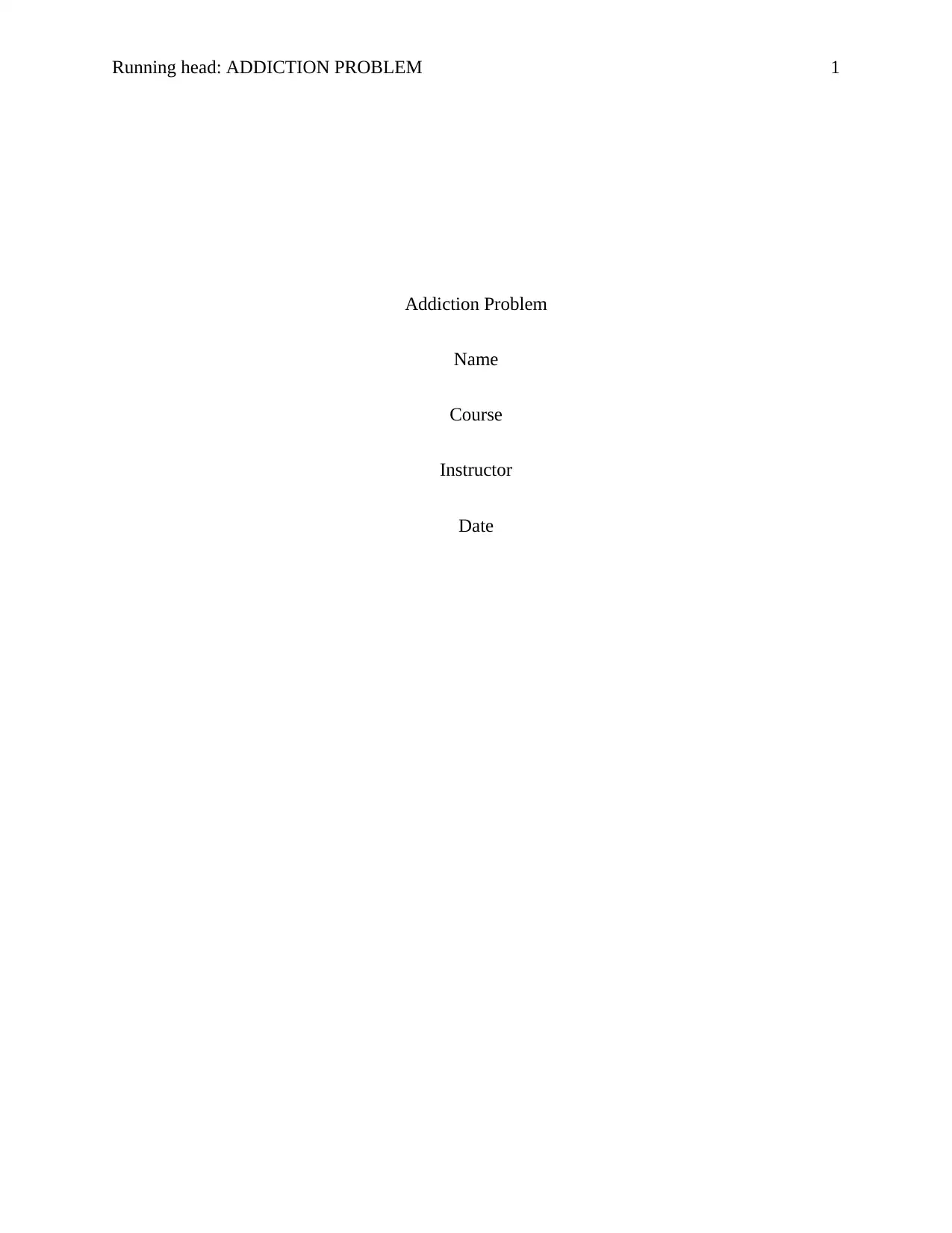
Running head: ADDICTION PROBLEM 1
Addiction Problem
Name
Course
Instructor
Date
Addiction Problem
Name
Course
Instructor
Date
Paraphrase This Document
Need a fresh take? Get an instant paraphrase of this document with our AI Paraphraser
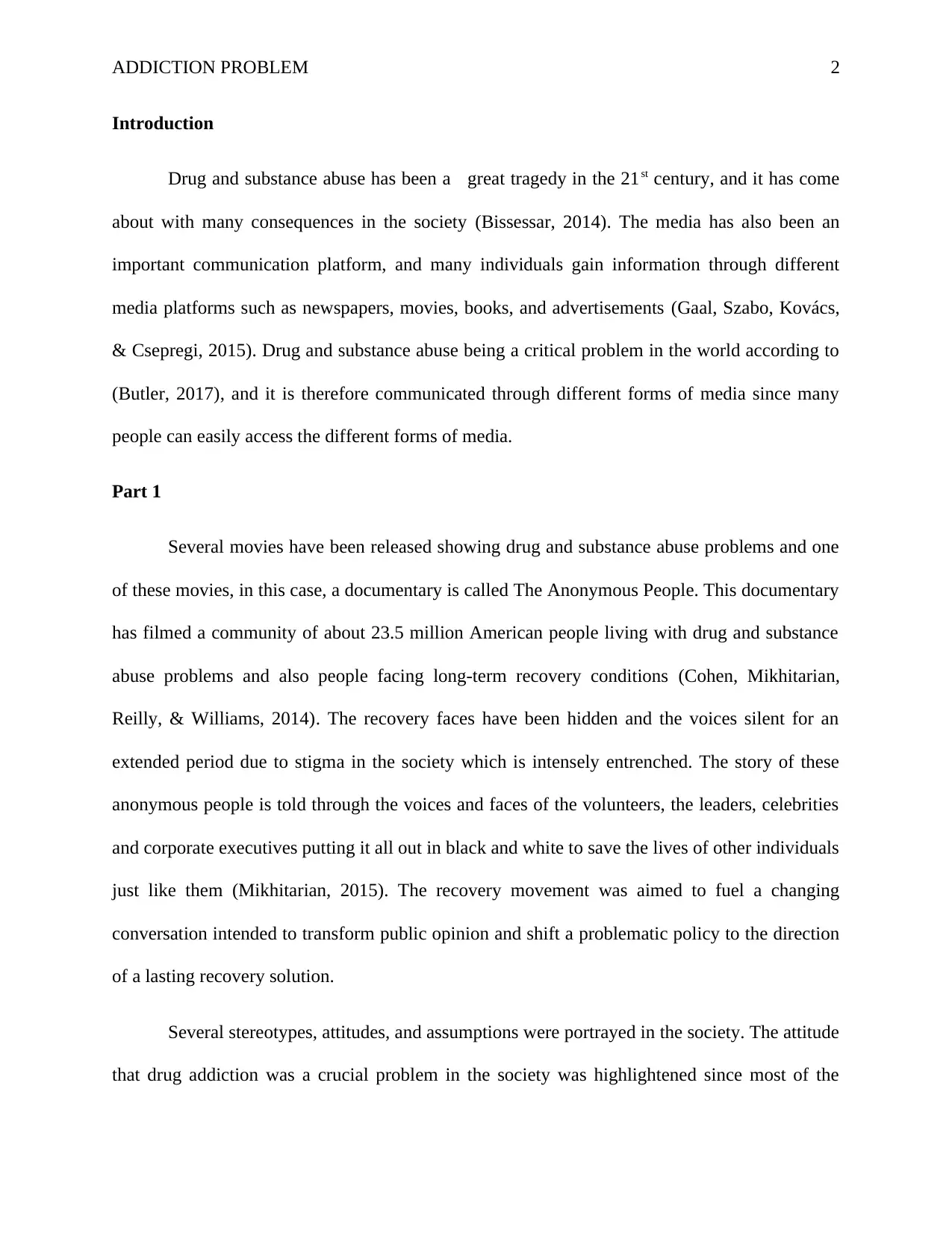
ADDICTION PROBLEM 2
Introduction
Drug and substance abuse has been a great tragedy in the 21st century, and it has come
about with many consequences in the society (Bissessar, 2014). The media has also been an
important communication platform, and many individuals gain information through different
media platforms such as newspapers, movies, books, and advertisements (Gaal, Szabo, Kovács,
& Csepregi, 2015). Drug and substance abuse being a critical problem in the world according to
(Butler, 2017), and it is therefore communicated through different forms of media since many
people can easily access the different forms of media.
Part 1
Several movies have been released showing drug and substance abuse problems and one
of these movies, in this case, a documentary is called The Anonymous People. This documentary
has filmed a community of about 23.5 million American people living with drug and substance
abuse problems and also people facing long-term recovery conditions (Cohen, Mikhitarian,
Reilly, & Williams, 2014). The recovery faces have been hidden and the voices silent for an
extended period due to stigma in the society which is intensely entrenched. The story of these
anonymous people is told through the voices and faces of the volunteers, the leaders, celebrities
and corporate executives putting it all out in black and white to save the lives of other individuals
just like them (Mikhitarian, 2015). The recovery movement was aimed to fuel a changing
conversation intended to transform public opinion and shift a problematic policy to the direction
of a lasting recovery solution.
Several stereotypes, attitudes, and assumptions were portrayed in the society. The attitude
that drug addiction was a crucial problem in the society was highlightened since most of the
Introduction
Drug and substance abuse has been a great tragedy in the 21st century, and it has come
about with many consequences in the society (Bissessar, 2014). The media has also been an
important communication platform, and many individuals gain information through different
media platforms such as newspapers, movies, books, and advertisements (Gaal, Szabo, Kovács,
& Csepregi, 2015). Drug and substance abuse being a critical problem in the world according to
(Butler, 2017), and it is therefore communicated through different forms of media since many
people can easily access the different forms of media.
Part 1
Several movies have been released showing drug and substance abuse problems and one
of these movies, in this case, a documentary is called The Anonymous People. This documentary
has filmed a community of about 23.5 million American people living with drug and substance
abuse problems and also people facing long-term recovery conditions (Cohen, Mikhitarian,
Reilly, & Williams, 2014). The recovery faces have been hidden and the voices silent for an
extended period due to stigma in the society which is intensely entrenched. The story of these
anonymous people is told through the voices and faces of the volunteers, the leaders, celebrities
and corporate executives putting it all out in black and white to save the lives of other individuals
just like them (Mikhitarian, 2015). The recovery movement was aimed to fuel a changing
conversation intended to transform public opinion and shift a problematic policy to the direction
of a lasting recovery solution.
Several stereotypes, attitudes, and assumptions were portrayed in the society. The attitude
that drug addiction was a crucial problem in the society was highlightened since most of the
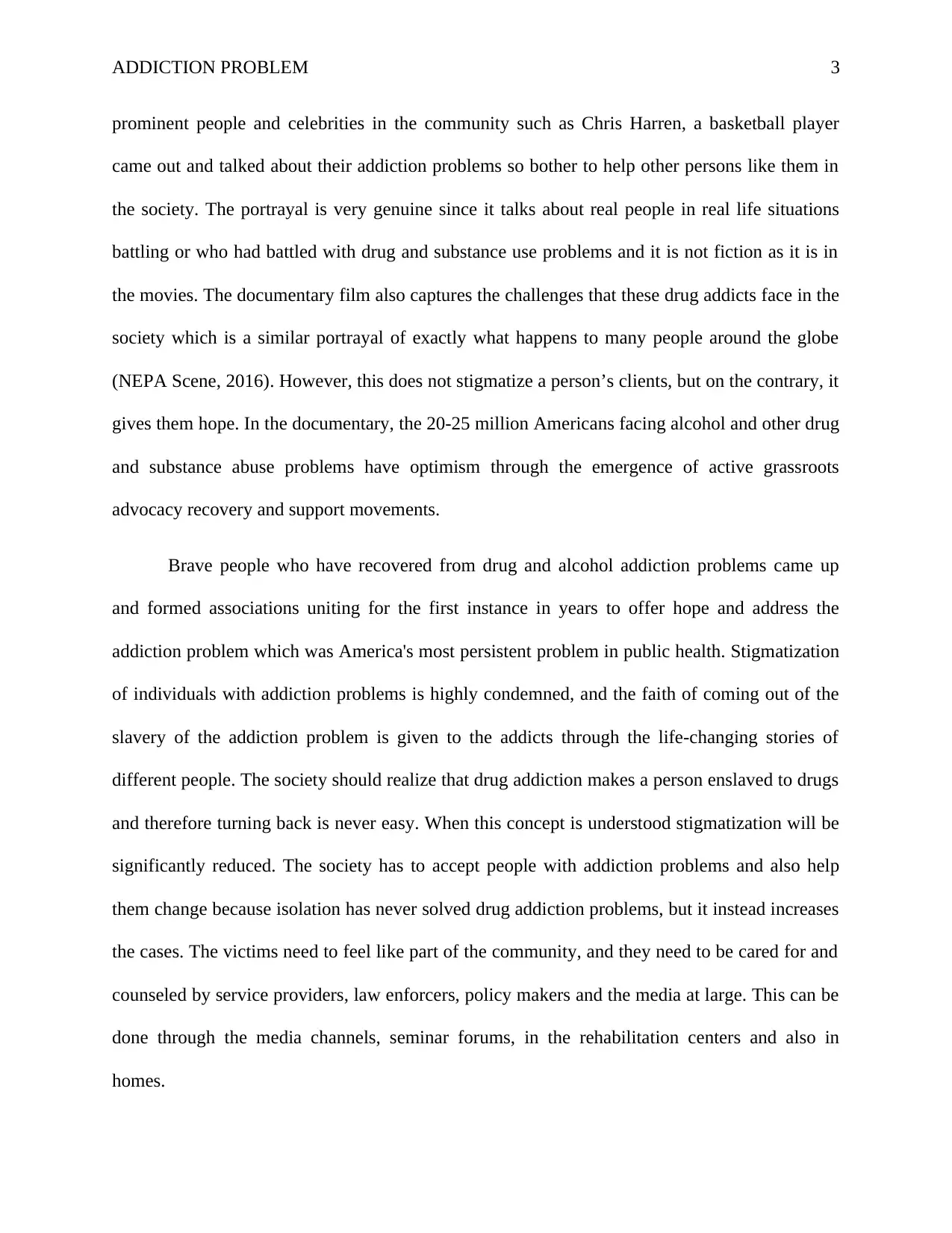
ADDICTION PROBLEM 3
prominent people and celebrities in the community such as Chris Harren, a basketball player
came out and talked about their addiction problems so bother to help other persons like them in
the society. The portrayal is very genuine since it talks about real people in real life situations
battling or who had battled with drug and substance use problems and it is not fiction as it is in
the movies. The documentary film also captures the challenges that these drug addicts face in the
society which is a similar portrayal of exactly what happens to many people around the globe
(NEPA Scene, 2016). However, this does not stigmatize a person’s clients, but on the contrary, it
gives them hope. In the documentary, the 20-25 million Americans facing alcohol and other drug
and substance abuse problems have optimism through the emergence of active grassroots
advocacy recovery and support movements.
Brave people who have recovered from drug and alcohol addiction problems came up
and formed associations uniting for the first instance in years to offer hope and address the
addiction problem which was America's most persistent problem in public health. Stigmatization
of individuals with addiction problems is highly condemned, and the faith of coming out of the
slavery of the addiction problem is given to the addicts through the life-changing stories of
different people. The society should realize that drug addiction makes a person enslaved to drugs
and therefore turning back is never easy. When this concept is understood stigmatization will be
significantly reduced. The society has to accept people with addiction problems and also help
them change because isolation has never solved drug addiction problems, but it instead increases
the cases. The victims need to feel like part of the community, and they need to be cared for and
counseled by service providers, law enforcers, policy makers and the media at large. This can be
done through the media channels, seminar forums, in the rehabilitation centers and also in
homes.
prominent people and celebrities in the community such as Chris Harren, a basketball player
came out and talked about their addiction problems so bother to help other persons like them in
the society. The portrayal is very genuine since it talks about real people in real life situations
battling or who had battled with drug and substance use problems and it is not fiction as it is in
the movies. The documentary film also captures the challenges that these drug addicts face in the
society which is a similar portrayal of exactly what happens to many people around the globe
(NEPA Scene, 2016). However, this does not stigmatize a person’s clients, but on the contrary, it
gives them hope. In the documentary, the 20-25 million Americans facing alcohol and other drug
and substance abuse problems have optimism through the emergence of active grassroots
advocacy recovery and support movements.
Brave people who have recovered from drug and alcohol addiction problems came up
and formed associations uniting for the first instance in years to offer hope and address the
addiction problem which was America's most persistent problem in public health. Stigmatization
of individuals with addiction problems is highly condemned, and the faith of coming out of the
slavery of the addiction problem is given to the addicts through the life-changing stories of
different people. The society should realize that drug addiction makes a person enslaved to drugs
and therefore turning back is never easy. When this concept is understood stigmatization will be
significantly reduced. The society has to accept people with addiction problems and also help
them change because isolation has never solved drug addiction problems, but it instead increases
the cases. The victims need to feel like part of the community, and they need to be cared for and
counseled by service providers, law enforcers, policy makers and the media at large. This can be
done through the media channels, seminar forums, in the rehabilitation centers and also in
homes.
⊘ This is a preview!⊘
Do you want full access?
Subscribe today to unlock all pages.

Trusted by 1+ million students worldwide
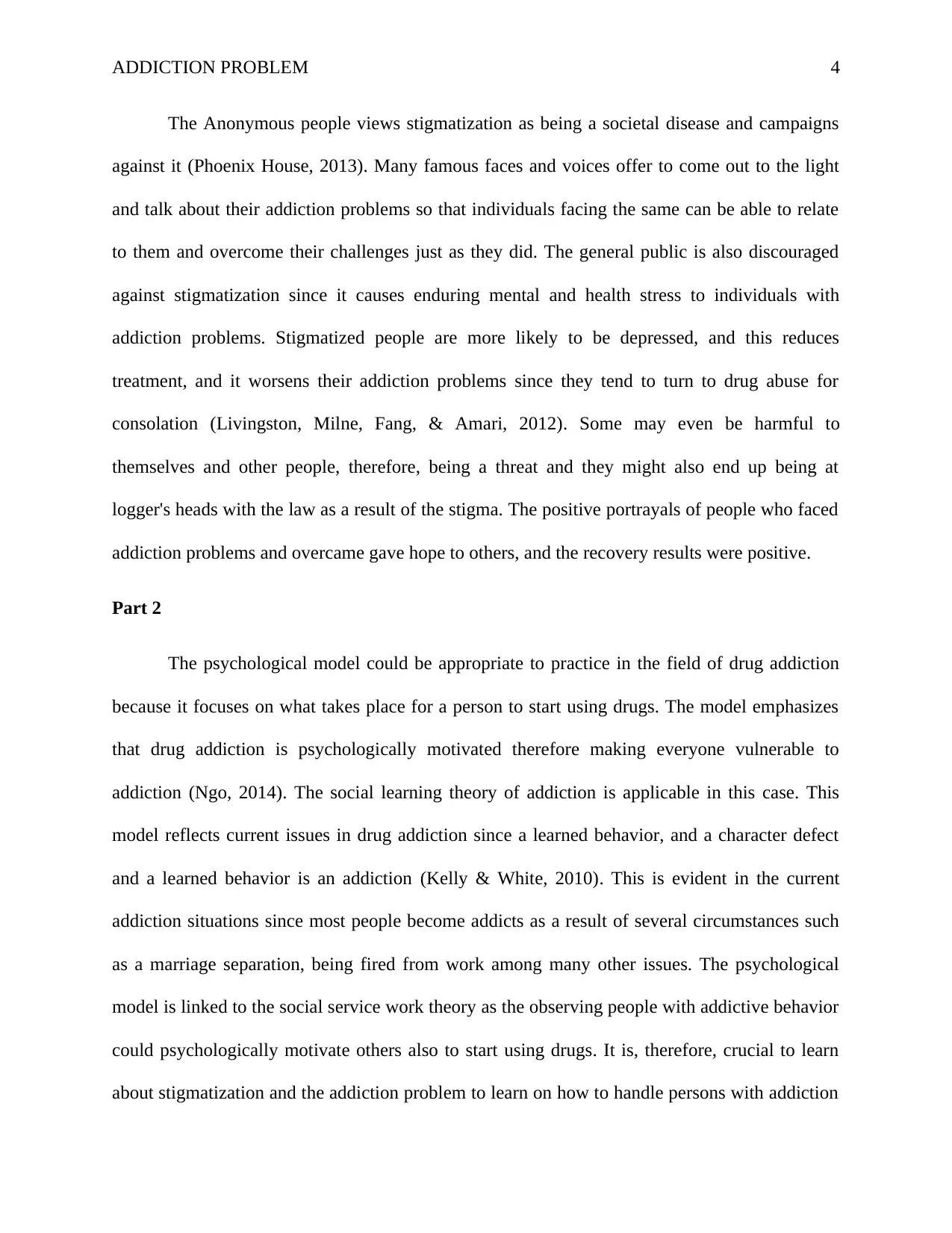
ADDICTION PROBLEM 4
The Anonymous people views stigmatization as being a societal disease and campaigns
against it (Phoenix House, 2013). Many famous faces and voices offer to come out to the light
and talk about their addiction problems so that individuals facing the same can be able to relate
to them and overcome their challenges just as they did. The general public is also discouraged
against stigmatization since it causes enduring mental and health stress to individuals with
addiction problems. Stigmatized people are more likely to be depressed, and this reduces
treatment, and it worsens their addiction problems since they tend to turn to drug abuse for
consolation (Livingston, Milne, Fang, & Amari, 2012). Some may even be harmful to
themselves and other people, therefore, being a threat and they might also end up being at
logger's heads with the law as a result of the stigma. The positive portrayals of people who faced
addiction problems and overcame gave hope to others, and the recovery results were positive.
Part 2
The psychological model could be appropriate to practice in the field of drug addiction
because it focuses on what takes place for a person to start using drugs. The model emphasizes
that drug addiction is psychologically motivated therefore making everyone vulnerable to
addiction (Ngo, 2014). The social learning theory of addiction is applicable in this case. This
model reflects current issues in drug addiction since a learned behavior, and a character defect
and a learned behavior is an addiction (Kelly & White, 2010). This is evident in the current
addiction situations since most people become addicts as a result of several circumstances such
as a marriage separation, being fired from work among many other issues. The psychological
model is linked to the social service work theory as the observing people with addictive behavior
could psychologically motivate others also to start using drugs. It is, therefore, crucial to learn
about stigmatization and the addiction problem to learn on how to handle persons with addiction
The Anonymous people views stigmatization as being a societal disease and campaigns
against it (Phoenix House, 2013). Many famous faces and voices offer to come out to the light
and talk about their addiction problems so that individuals facing the same can be able to relate
to them and overcome their challenges just as they did. The general public is also discouraged
against stigmatization since it causes enduring mental and health stress to individuals with
addiction problems. Stigmatized people are more likely to be depressed, and this reduces
treatment, and it worsens their addiction problems since they tend to turn to drug abuse for
consolation (Livingston, Milne, Fang, & Amari, 2012). Some may even be harmful to
themselves and other people, therefore, being a threat and they might also end up being at
logger's heads with the law as a result of the stigma. The positive portrayals of people who faced
addiction problems and overcame gave hope to others, and the recovery results were positive.
Part 2
The psychological model could be appropriate to practice in the field of drug addiction
because it focuses on what takes place for a person to start using drugs. The model emphasizes
that drug addiction is psychologically motivated therefore making everyone vulnerable to
addiction (Ngo, 2014). The social learning theory of addiction is applicable in this case. This
model reflects current issues in drug addiction since a learned behavior, and a character defect
and a learned behavior is an addiction (Kelly & White, 2010). This is evident in the current
addiction situations since most people become addicts as a result of several circumstances such
as a marriage separation, being fired from work among many other issues. The psychological
model is linked to the social service work theory as the observing people with addictive behavior
could psychologically motivate others also to start using drugs. It is, therefore, crucial to learn
about stigmatization and the addiction problem to learn on how to handle persons with addiction
Paraphrase This Document
Need a fresh take? Get an instant paraphrase of this document with our AI Paraphraser
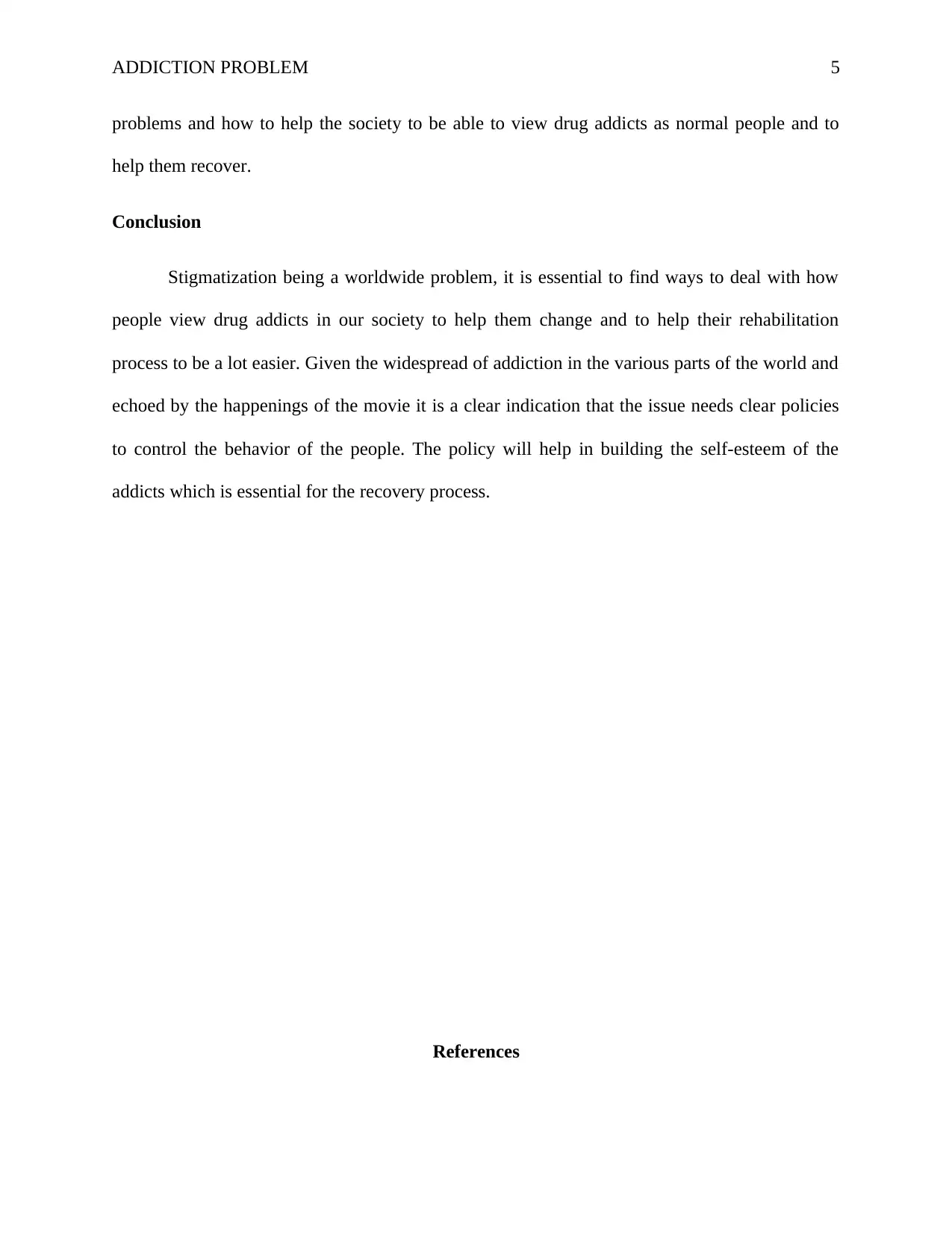
ADDICTION PROBLEM 5
problems and how to help the society to be able to view drug addicts as normal people and to
help them recover.
Conclusion
Stigmatization being a worldwide problem, it is essential to find ways to deal with how
people view drug addicts in our society to help them change and to help their rehabilitation
process to be a lot easier. Given the widespread of addiction in the various parts of the world and
echoed by the happenings of the movie it is a clear indication that the issue needs clear policies
to control the behavior of the people. The policy will help in building the self-esteem of the
addicts which is essential for the recovery process.
References
problems and how to help the society to be able to view drug addicts as normal people and to
help them recover.
Conclusion
Stigmatization being a worldwide problem, it is essential to find ways to deal with how
people view drug addicts in our society to help them change and to help their rehabilitation
process to be a lot easier. Given the widespread of addiction in the various parts of the world and
echoed by the happenings of the movie it is a clear indication that the issue needs clear policies
to control the behavior of the people. The policy will help in building the self-esteem of the
addicts which is essential for the recovery process.
References
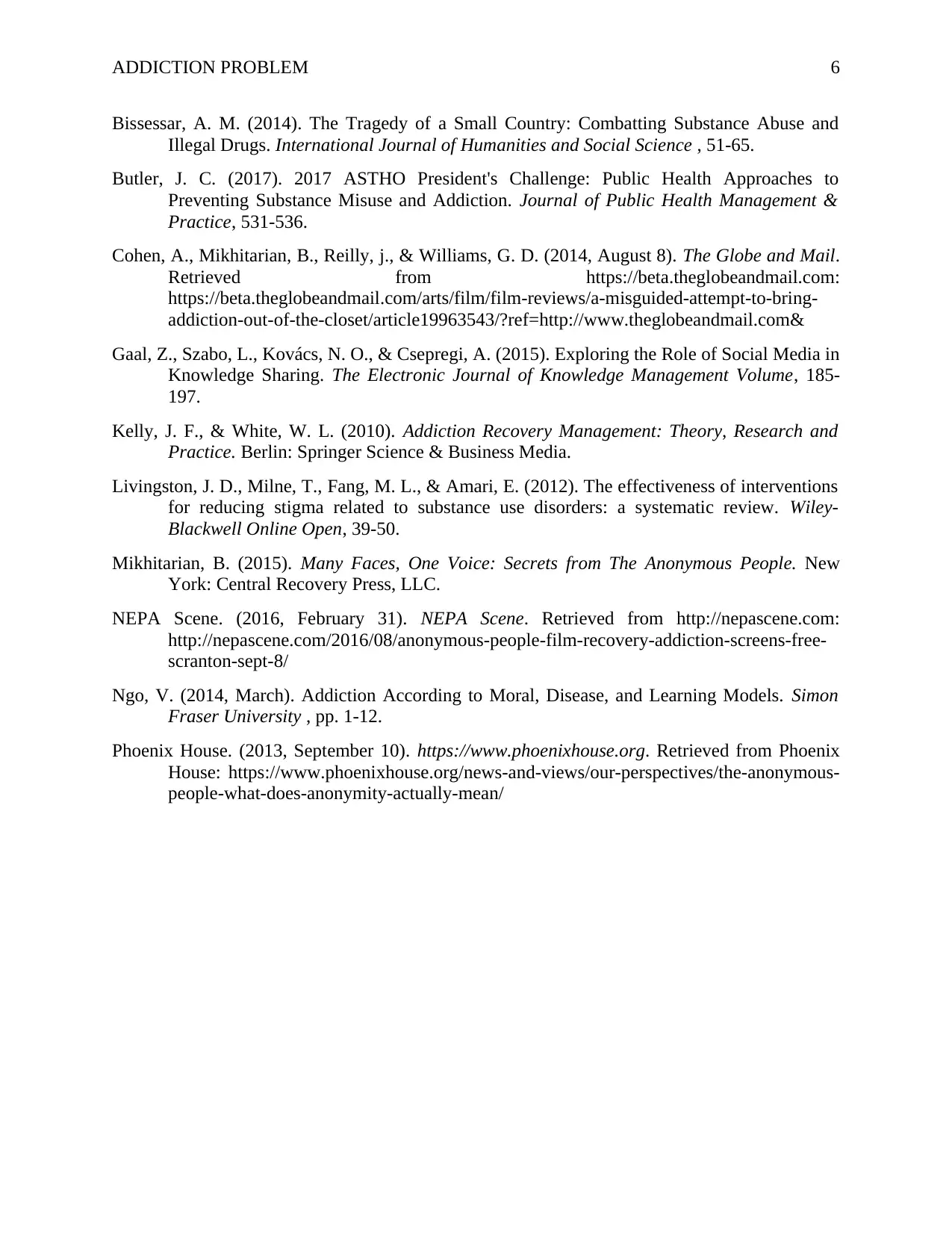
ADDICTION PROBLEM 6
Bissessar, A. M. (2014). The Tragedy of a Small Country: Combatting Substance Abuse and
Illegal Drugs. International Journal of Humanities and Social Science , 51-65.
Butler, J. C. (2017). 2017 ASTHO President's Challenge: Public Health Approaches to
Preventing Substance Misuse and Addiction. Journal of Public Health Management &
Practice, 531-536.
Cohen, A., Mikhitarian, B., Reilly, j., & Williams, G. D. (2014, August 8). The Globe and Mail.
Retrieved from https://beta.theglobeandmail.com:
https://beta.theglobeandmail.com/arts/film/film-reviews/a-misguided-attempt-to-bring-
addiction-out-of-the-closet/article19963543/?ref=http://www.theglobeandmail.com&
Gaal, Z., Szabo, L., Kovács, N. O., & Csepregi, A. (2015). Exploring the Role of Social Media in
Knowledge Sharing. The Electronic Journal of Knowledge Management Volume, 185-
197.
Kelly, J. F., & White, W. L. (2010). Addiction Recovery Management: Theory, Research and
Practice. Berlin: Springer Science & Business Media.
Livingston, J. D., Milne, T., Fang, M. L., & Amari, E. (2012). The effectiveness of interventions
for reducing stigma related to substance use disorders: a systematic review. Wiley-
Blackwell Online Open, 39-50.
Mikhitarian, B. (2015). Many Faces, One Voice: Secrets from The Anonymous People. New
York: Central Recovery Press, LLC.
NEPA Scene. (2016, February 31). NEPA Scene. Retrieved from http://nepascene.com:
http://nepascene.com/2016/08/anonymous-people-film-recovery-addiction-screens-free-
scranton-sept-8/
Ngo, V. (2014, March). Addiction According to Moral, Disease, and Learning Models. Simon
Fraser University , pp. 1-12.
Phoenix House. (2013, September 10). https://www.phoenixhouse.org. Retrieved from Phoenix
House: https://www.phoenixhouse.org/news-and-views/our-perspectives/the-anonymous-
people-what-does-anonymity-actually-mean/
Bissessar, A. M. (2014). The Tragedy of a Small Country: Combatting Substance Abuse and
Illegal Drugs. International Journal of Humanities and Social Science , 51-65.
Butler, J. C. (2017). 2017 ASTHO President's Challenge: Public Health Approaches to
Preventing Substance Misuse and Addiction. Journal of Public Health Management &
Practice, 531-536.
Cohen, A., Mikhitarian, B., Reilly, j., & Williams, G. D. (2014, August 8). The Globe and Mail.
Retrieved from https://beta.theglobeandmail.com:
https://beta.theglobeandmail.com/arts/film/film-reviews/a-misguided-attempt-to-bring-
addiction-out-of-the-closet/article19963543/?ref=http://www.theglobeandmail.com&
Gaal, Z., Szabo, L., Kovács, N. O., & Csepregi, A. (2015). Exploring the Role of Social Media in
Knowledge Sharing. The Electronic Journal of Knowledge Management Volume, 185-
197.
Kelly, J. F., & White, W. L. (2010). Addiction Recovery Management: Theory, Research and
Practice. Berlin: Springer Science & Business Media.
Livingston, J. D., Milne, T., Fang, M. L., & Amari, E. (2012). The effectiveness of interventions
for reducing stigma related to substance use disorders: a systematic review. Wiley-
Blackwell Online Open, 39-50.
Mikhitarian, B. (2015). Many Faces, One Voice: Secrets from The Anonymous People. New
York: Central Recovery Press, LLC.
NEPA Scene. (2016, February 31). NEPA Scene. Retrieved from http://nepascene.com:
http://nepascene.com/2016/08/anonymous-people-film-recovery-addiction-screens-free-
scranton-sept-8/
Ngo, V. (2014, March). Addiction According to Moral, Disease, and Learning Models. Simon
Fraser University , pp. 1-12.
Phoenix House. (2013, September 10). https://www.phoenixhouse.org. Retrieved from Phoenix
House: https://www.phoenixhouse.org/news-and-views/our-perspectives/the-anonymous-
people-what-does-anonymity-actually-mean/
⊘ This is a preview!⊘
Do you want full access?
Subscribe today to unlock all pages.

Trusted by 1+ million students worldwide
1 out of 6
Your All-in-One AI-Powered Toolkit for Academic Success.
+13062052269
info@desklib.com
Available 24*7 on WhatsApp / Email
![[object Object]](/_next/static/media/star-bottom.7253800d.svg)
Unlock your academic potential
Copyright © 2020–2025 A2Z Services. All Rights Reserved. Developed and managed by ZUCOL.
